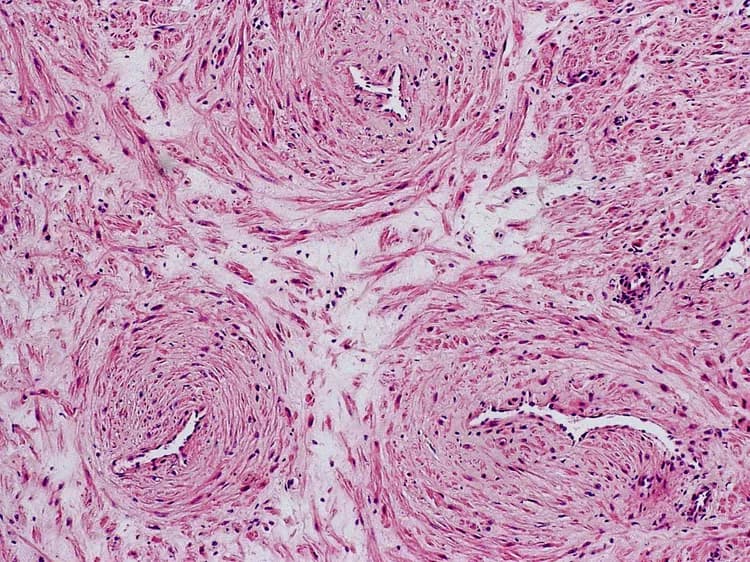What are the other Names for this Condition? (Also known as/Synonyms)
- Angiomyoma
- Vascular Leiomyoma
What is Angioleiomyoma? (Definition/Background Information)
- Angioleiomyoma is a benign tumor occurring just below the skin, affecting the smooth muscles of blood vessels (arteries and veins). It is characterized by the presence of thick-walled vascular channels
- These slow-growing solitary tumors are fairly common; their presence is felt by a distinct pain in about 60% of the cases
- Angioleiomyoma usually affects the lower limbs. Other tumor areas include the head and trunk. Women in their mid-adult phase are commonly affected
- It is a benign tumor and complete surgical excision is curative
Who gets Angioleiomyoma? (Age and Sex Distribution)
- Angioleiomyoma is generally present in middle-aged individuals, mostly women. The peak age range at occurrence being 30-50 years
- Tumors in the upper limbs and head are commonly found in men
- There is no ethnic/racial preference observed
What are the Risk Factors for Angioleiomyoma? (Predisposing Factors)
No risk factors are evident.
It is important to note that having a risk factor does not mean that one will get the condition. A risk factor increases ones chances of getting a condition compared to an individual without the risk factors. Some risk factors are more important than others.
Also, not having a risk factor does not mean that an individual will not get the condition. It is always important to discuss the effect of risk factors with your healthcare provider.
What are the Causes of Angioleiomyoma? (Etiology)
The exact cause of Angioleiomyoma formation is unknown; they are thought to occur spontaneously.
What are the Signs and Symptoms of Angioleiomyoma?
The presentations are based on the location of Angioleiomyoma. Signs and symptoms of these include:
- Angioleiomyoma are slow-growing, small, solitary tumors, forming mostly below the skin surface or deep inside the body tissues. They appear as painful lesions and are visible only after many years of growth
- Factors such as weather (cold, wind), pressure, pregnancy, and even menstruation, are known to increase the pain. The pain is a result of nerve fibers present within the tumor
- Most common locations of the lesions are the legs. Other locations include the hands, head, body trunk, and occasionally the mouth, tongue, and scrotum
How is Angioleiomyoma Diagnosed?
Due to benign nature and small size of the tumor, Angioleiomyoma are difficult to detect. A few diagnostic tests include:
- Physical exam with evaluation of medical history
- CT, MRI scan (of the affected region, for non-skin tumor)
- Ultrasound (of the affected region, for non-skin tumor)
- Biopsy of the mass: Histopathological studies conducted on a biopsy specimen, by a pathologist will reveal a sharply defined tumor boundary
Many clinical conditions may have similar signs and symptoms. Your healthcare provider may perform additional tests to rule out other clinical conditions to arrive at a definitive diagnosis.
What are the possible Complications of Angioleiomyoma?
The complications from Angioleiomyoma include:
- Recurrence of the tumor after surgery; however, this is very rare
- Damage to vital nerves, blood vessels, and surrounding structures during surgery
How is Angioleiomyoma Treated?
Treatment measures for Angioleiomyoma include:
- If there are no symptoms associated with Angioleiomyoma, then non-operative measures are adopted. However, periodic observations are maintained and any pain is controlled using pain medications
- For painful Angioleiomyomas, complete surgical excision of the lesion is normally sufficient treatment
- Post-operative care is important: Minimum activity level is to be ensured until the surgical wound heals
- Follow-up care with regular screening and check-ups are important
How can Angioleiomyoma be Prevented?
Current medical research has not established a way of preventing Angioleiomyoma occurrence.
What is the Prognosis of Angioleiomyoma? (Outcomes/Resolutions)
- Prognosis is generally excellent when lesions are small and found below the skin surface. Their recurrence risk can also be entirely avoided with complete surgical excision
- The probability of Angioleiomyoma recurrence is very low after its surgical removal. However, periodic follow-up with screening might be required
Additional and Relevant Useful Information for Angioleiomyoma:
- Histopathologically, Angioleiomyoma has 3 subtypes: Solid/Capillary (found on the legs), Cavernous (on the arms), and Venous (on the head). A pathologist will be able to classify the tumor after examining them under a microscope
- Angioleiomyoma is a painful skin tumor. Other painful tumors occurring under the skin are grouped under the acronym “ANGEL”, which is: Angiolipoma, Neuroma, Glomus Tumor, Eccrine Spiradenoma, and Leiomyoma
- Another mnemonic proposed for painful skin tumors is “LEND AN EGG”, which is: Leiomyoma, Eccrine Spiradenoma, Neuroma, Dermatofibroma, Neurilemmoma, Endometrioma, Glomus Tumor, and Granular cell tumor
Related Articles
Test Your Knowledge
Asked by users
Related Centers
Related Specialties
Related Physicians
Related Procedures
Related Resources
Join DoveHubs
and connect with fellow professionals


0 Comments
Please log in to post a comment.